Here’s your first official look at the new seventh generation Volkswagen Golf. It’s roomier and more technologically advanced than the 29 million Golfs to have gone before it. It’s also up to 100kg lighter than the previous model, enough to help it become 23% more efficient.
It’s no surprise to see Volkswagen has taken an evolutionary path for its most important model. We can’t say we’re completely won over by the new look. But the more you absorb the pictures you see here the more you appreciate some of the smaller details. Having said that, it’s very a much a safe step forward. Although, the image above, with larger wheels, shows the Mk7 in a good light and we hold high hopes for the look of the forthcoming GTI and R models.
The Mk7 Golf is built on the MQB platform which uses a raft of standard measures to help Volkswagen save some cash, while being versatile enough to underpin several models and classes of cars across the Volkswagen Group brand portfolio.
We’ve already gone over the basic dimensions of the Golf VII with you. But to recap, the new model is 56mm longer, 13mm wider and 28mm lower than the Golf VI. The front wheels have been moved 43mm forward, while the overall wheelbase has been extended by 59mm. Overall the new Golf is 4255mm long, 1799mm wide and 1452mm high. Its drag coefficient of 0.27 is 10% better than the previous generation.
Inside the car those new exterior dimensions allow for more rear seat legroom, more shoulder and elbow room for all passengers as well as increased cargo space in the boot.
The centre console is now slightly angled towards the driver and all models of Golf, from entry level to top of the range, feature a full colour touchscreen display. Sizes start 5.8″ and go up to a maximum of 8″. Finger gestures, as seen with smartphones, are used to control the system.
Volkswagen has followed the recent trend of removing traditional handbrake levers in place of an electronic switch. They say this gives front seat passengers a bit more room. They’ve also managed to house a universal mobile phone holder in the central storage compartment with the added benefit of an inductive aerial for improved reception.
As you’d expect VW has packed the Golf VII with a host of new safety features. As well as the now default system like ABS, EBD and ESP new braking features such as multi-collision braking, Front Assist and City Emergency Braking are available. These can complemented by things like the PreCrash system, Adaptive Cruise Control, Driver Alert System, a camera-operated Lane Assist system, Dynamic Light Assist and Park Assist.
Preset driving modes are also available on the new Golf. Standard settings include Eco, Sport, Normal and Individual. Those opting for a DSG transmission can boast a fifth setting, called Comfort.
Steering for the Mk7 is now handled by a variable ratio system, which brings greater manoeuvrability at low speeds, while being more composed and direct at higher speeds.
At launch Volkswagen has announced a modest engine range of two diesel and two petrol units. The TDI engines start with a 1.6 litre offering 77kW and a 2.0 litre with 110kW. Respectively, their combined fuel usage figures are 3.8l/100km and 4.1l/100km. The petrol powered range begins with a 1.2 litre TSI offering 63kW of power and fuel consumption of 4.9l/100km. A 1.4 litre TSI provides 103kW and with the addition of Active Cylinder Technology, which can deactivate two of the cylinders, sips fuel at the rate of 4.8l/100km.
More detail on the Golf VII will be published when the cars hit the stands at the Paris Motor Show, at which point we also hope to see a GTI concept. For now there’s an additional 19 pictures and press guff for you after the break, including a 44 page PDF for you to download.
UPDATE: Three new PDFs have been added ready for download. We recommend sinking your teeth into the first two.
UPDATE #2: This just in from Volkswagen Australia: “We are planning to launch the Golf VII in the 2nd qtr 2013.”
From Volkswagen UK:
Seventh generation Volkswagen Golf breaks cover in Berlin
4 September 2012. The all-new Volkswagen Golf has been unveiled in Berlin, 36 years after the original model redefined the small family car. The seventh generation Golf builds on the success of its predecessors, of which over 29 million have been sold, bringing new levels of comfort, practicality, safety and efficiency to the class.
Despite offering more room for passengers and more advanced technological features than ever before, new production techniques contribute to the Mk VII Golf being up to 100 kg lighter than the car it replaces, helping to make it up to 23 per cent more efficient than before. On top of this, the new Golf is also safer than ever, thanks not just to a stronger body structure (which is also 23 kg lighter) but also to a raft of standard and optional passive and active safety systems.
The new Golf is built on the so-called MQB (Modularer Querbaukasten) platform or Modular Transverse Matrix. This standardises many vehicle component parameters across brands and vehicle classes, and allows access to new powertrains and technologies, including innovations in the areas of safety and infotainment, which until now were reserved for vehicles in higher segments.
At 4,255 mm long, the new Golf is 56 mm longer than its predecessor, with a 59 mm longer wheelbase of 2,637 mm. The front wheels are 43 mm further forward, helping to generate more interior space, while the Golf is also 13 mm wider, at 1,799 mm, and 28 mm lower, at 1,452 mm. This helps to create a 10 per cent improvement in the drag co-efficient, which is now 0.27 Cd.
Though the new car’s dimensions are larger, its overall design is unmistakeably that of a Golf, thanks to a design DNA that has evolved through the decades. Walter de Silva, Head of Design for Volkswagen AG, said: ‘One of the keys to the Golf’s success lies in its continuity. There are a handful of cars with a design that, like the Golf’s, has been refined, tweaked and enhanced down the decades and thus become timeless.’
Inside the Golf there is more room than ever. Rear legroom is improved by 15 mm, and the front seats have been moved 20 mm further back, benefitting taller drivers. Front shoulder room is improved by 31 mm to 1,420 mm (at the rear it is 30 mm wider) and elbow room by 22 mm to 1,469 mm (20 mm wider at the rear). There is more room for luggage, too: the boot is 30 litres larger, at 380 litres, with a low 685 mm sill to make loading effortless. The front passenger seat can also optionally fold fully forward, creating a loadspace which is up to 2,412 mm long.
In the cockpit, the centre console is now angled more towards the driver, giving them easier, more ergonomic and direct access to auxiliary controls, including the new generation of touchscreen infotainment systems that is available on the Golf. All Golf models now have touchscreen systems as standard, starting in the UK with a 5.8-inch colour display system, and rising to the range-topping satellite navigation system with eight-inch colour display. It operates with finger gestures that will be familiar to smartphone users. Features include DAB digital radio, auxiliary inputs (including USB), Bluetooth telephone preparation and access to vehicle trip information.
Between the front seats, space is increased by virtue of the new electronic parking brake with auto-hold feature. And for the first time in a Volkswagen, the compartment under the centre armrest optionally includes a universal phone holder with inductive aerial, which not only increases the signal strength of a phone placed in it, but also reduces the drain on the phone’s battery.
The new Golf also features a number of innovative standard safety systems, while optional systems include many previously only available on vehicles in a class above. Standard on all new Golf models is a multi-collision brake system. This automatically brakes the vehicle after a collision, to reduce kinetic energy significantly and thus minimise the chance of a second impact. Research in Germany shows that around a quarter of accidents involving personal injury are multi-collision events. Also standard is the PreCrash system that made its debut on the Touareg. If it detects the possibility of an accident, it pre-tensions seatbelts and closes the windows and sunroof, leaving just a small gap, to ensure the best possible protection from the airbags.
Other electronic aids include Adaptive Cruise Control (standard in the UK from SE models upwards), which uses radar sensors to maintain a set distance from the vehicle in front; Front Assist, which can bring the vehicle to a complete stop and operates at speeds of up to 150 km/h (approx. 93 mph); and City Emergency Braking, which operates at up to 30 km/h (approx. 19 mph), and can reduce or prevent the chance of accidents occurring. A Driver Alert System, as introduced on the Passat, monitors the driver’s inputs, to detect any signs of tiredness; while a camera-operated Lane Assist system can help keep the car in a specific lane, providing countersteering assistance where necessary. A Dynamic Light Assist system optionally masks the vehicle’s high beam lighting, making for brilliant illumination without dazzling on-coming traffic.
The Golf’s steering now uses a variable ratio system that offers more agile steering in dynamic driving situations, while ensuring high-speed stability, and easy manoeuvring in the city. Specify the latest generation Park Assist, and the new Golf will even park itself in a space no more than 80 cm longer than the vehicle.
For the first time, the Golf is also available with driver profile selection, which allows the driver to choose from four modes – Eco, Sport, Normal and Individual; with a DSG gearbox a fifth option – Comfort – is also offered. Each of these modes alters the throttle mapping and engine management (among other parameters) to the chosen style, so in Eco mode, for example, the engine management, air conditioning and ancillary systems are controlled to achieve maximum fuel consumption.
Powering the Golf is a new range of petrol and diesel engines, all of which incorporate Stop/Start and battery regeneration systems. At launch, the petrol engines are a 1.2-litre TSI 85 PS unit returning 4.9 l/100 km (around 57.6 mpg and 113 g/km), and a 1.4-litre TSI 140 PS unit with Active Cylinder Technology, which can deactivate two of the cylinders, and achieves up to 4.8 l/100 km (58.9 mpg and 112 g/km). The launch diesel engines are a 1.6-litre unit with 105 PS, which returns 3.8 l/100 km (74.3 mpg and 99 g/km), and a 2.0-litre 150 PS unit which returns 4.1 l/100 km (68.9 mpg and 106 g/km).
Further details on the new Golf will be revealed at the Paris Motor Show. The car will go on sale from October, with the first UK deliveries expected in January 2013.
Downloads
- The Golf. 2012 World Premiere. (4.1mb PDF)*
- The Golf. 2012 Workshop. (2.3mb PDF)*
- The new Golf. Das Auto. (470kb PDF)
- The new Golf 1.4l TSI & 1.6l TDI tech specs (14kb PDF)
*Recommended downloads.
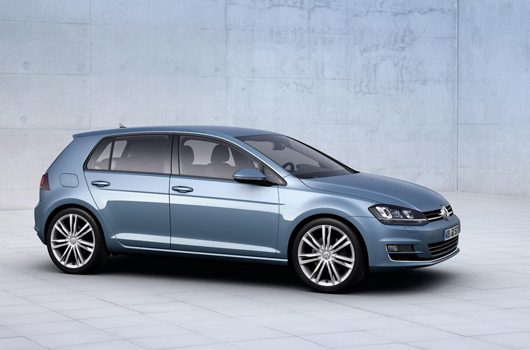
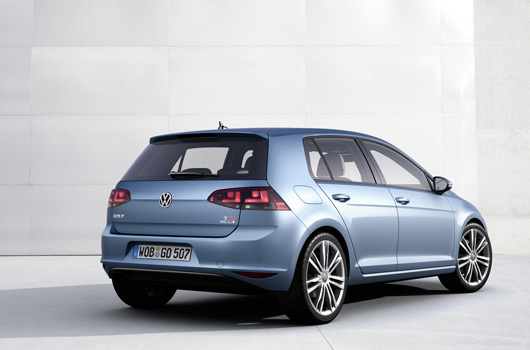
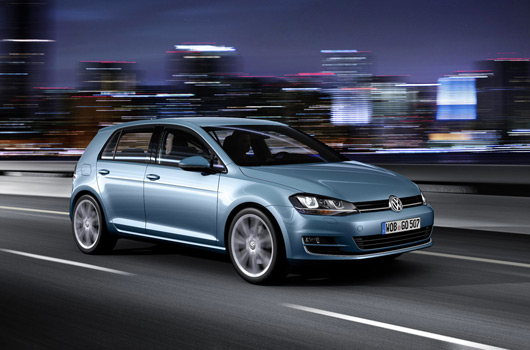
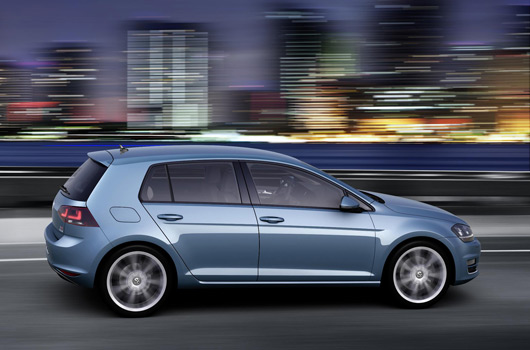
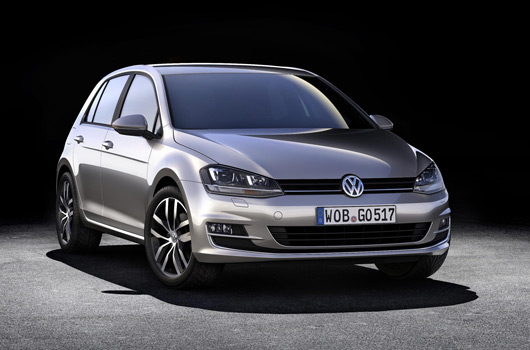
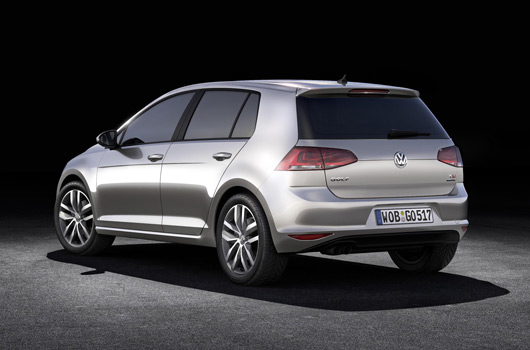
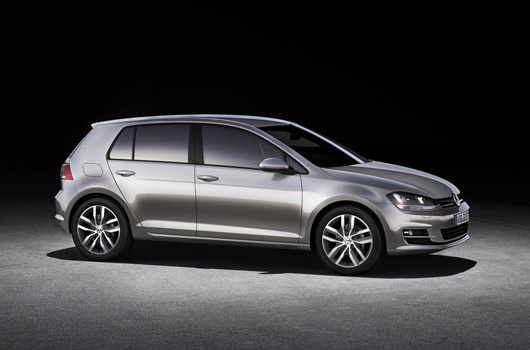
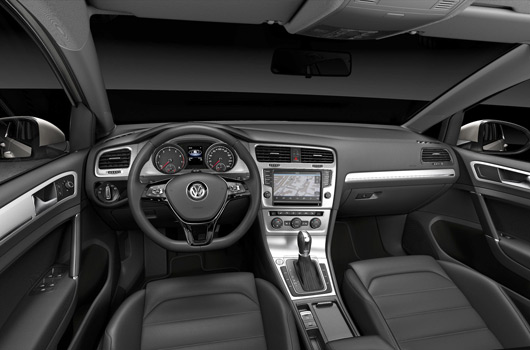
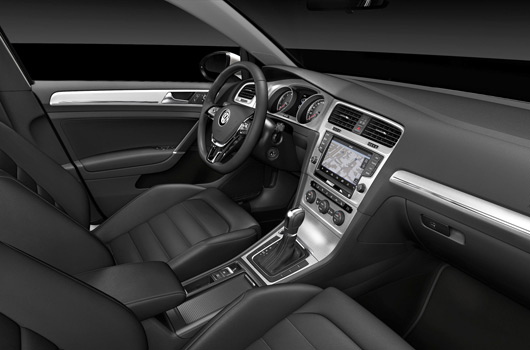
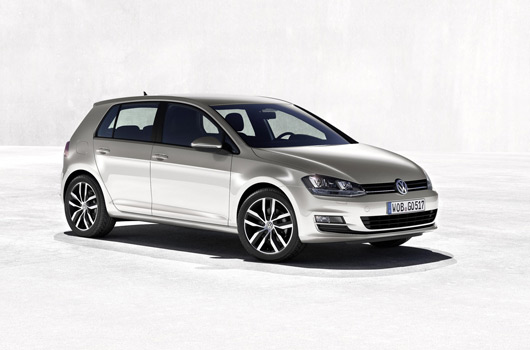
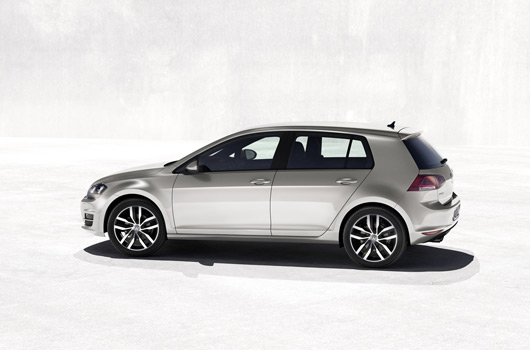
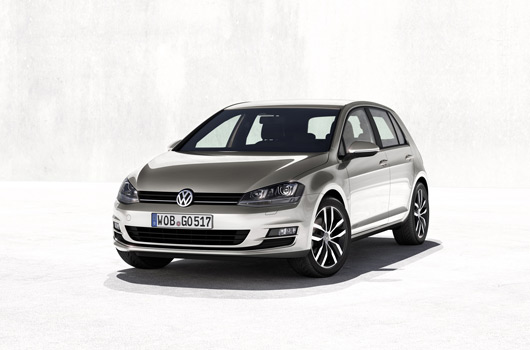
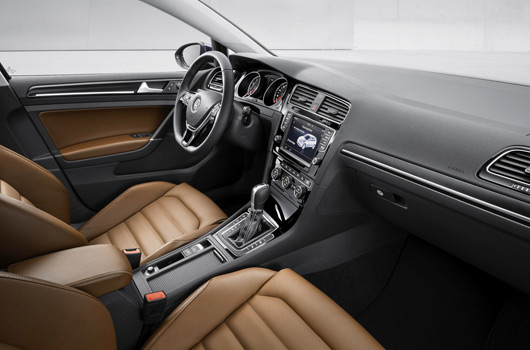
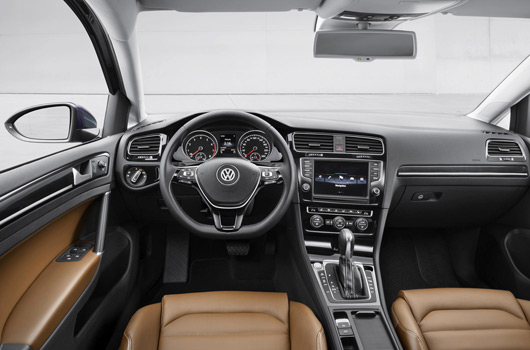
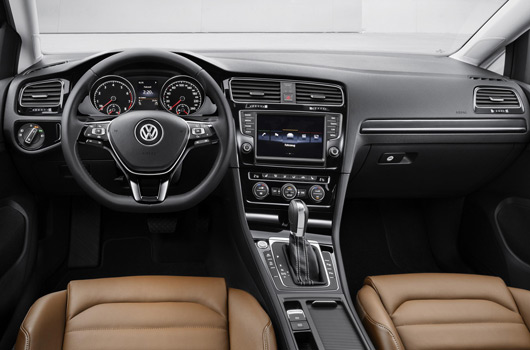
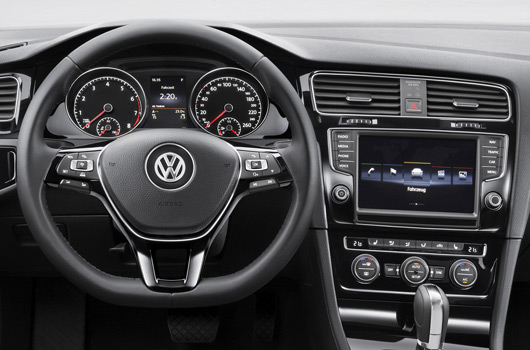
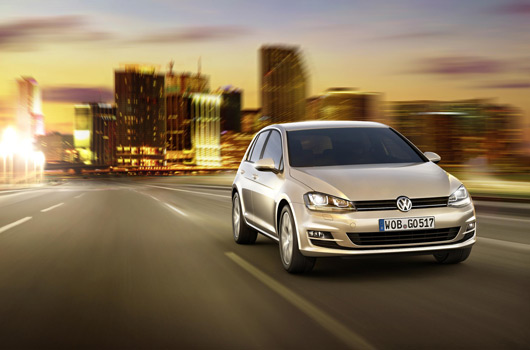
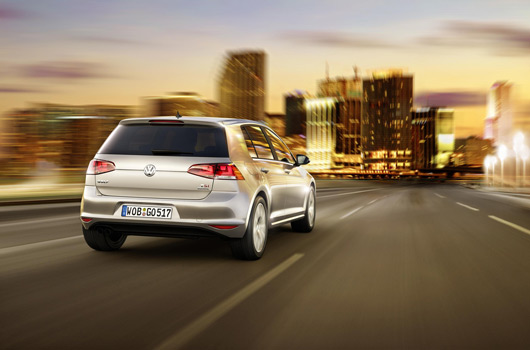
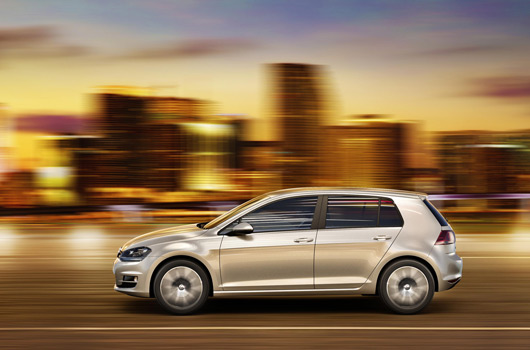
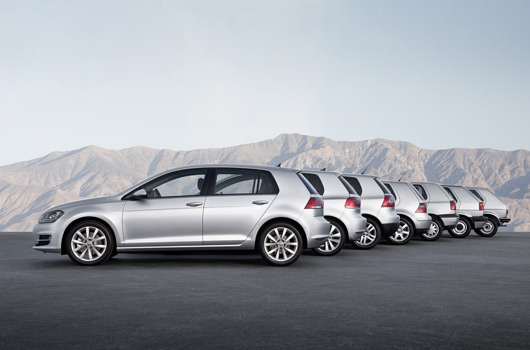
27 replies on “Volkswagen Golf VII revealed”
Hmm, very nice, but a bit underwhelming aesthetically .
Not exactly a great leap forward design wise.
I was hoping for something more revolution vs. evolution – like the mk5 vs mk4.
The interior/centre console in particular has become very generic
Big Polo.
dont see much to make me want to upgrade from the MkV,
although the milage in the V is getting up there.
Can we have some more interesting colours this time please
*yawn* looks like even less of an evolution than from the MkV to Mk6
I can see the engine start/stop button… and a bloody push-button electronic handbrake, wants wrong with a nice manual lever?
[…] this series of seven images we compare the new Mk7 Golf against the previous Mk6 model. As is often the case with new releases, it’s not until you […]
ZZZZZZ
[…] Volkswagen Golf VII revealed […]
[…] assembled a collection of new videos showcasing the new Volkswagen Golf VII. Be sure to keep an eye on this post as we’ll be sure to add new videos as they come to […]
The Golf is the 911 of hatches, can’t see why they’d mess with the formula. Very reminiscent of the MkIV
Like every Golf, the more you look at it the better it gets.
I think it looks fantastic – and it will look even better in the metal. For all the criticism, can anyone name a better looking hatch?
C-pillar? Check. Dual headlamps? Check (ok, they’re not circular but they look pretty good). All the other nice details are just icing on the cake (the fat wheel arches, for example).
The only thing that looks off to me is that horrible silver interior finish. Hopefully piano black is an option on all models.
Oh, and have a read of that engine spec sheet above. Very impressive.
I’m with you Matt. Especially on that early 90s silver interior trim. And after looking at the pics for a few hours now, I’m starting to really like the Mk7.
But if my memory of the Mk5 and Mk6 launches are anything to go by there’ll be a lot of hangers on not willing to embrace the new car!
Is the 1.4. A straight up single turbo? Apart from the silver centre console the interior looks less cheap than the Mk6. But bigger all around it’s squeezy enough in my garage as it is.
Yes 1.4 single turbo. Also Matt second set of interior photos shows piano black.
After now witnessing my 3rd Golf Marque release, this is the first one I have liked straight up.
It’s a touch Astra, but it will be better in the flesh.
The interior is MK6 esque but I dig the black one.
That new headunit looks badass!
Conservative and not wanting to offend anyone IMHO. Quite similar to the current model for the general public, which will make it dated in years to come
Reminds me of the recent BMW 3 series. The new 3 series looks ok in photos, but in the flesh looks so similar to the last series that I have yet to notice one on the road, even though I am sure I have driven by hundreds.
I can understand why in the current Euro / US market companies are wanting to play it safe, but it makes life boring
[…] far Volkswagen has only presented us with official pics of the five door Golf VII. But if you go to the German Volkswagen website and muck around with their online configurator you […]
Those pics added showing the black trim on the main console improve things a lot on the inside.
Plain Jane.
Too many people are quick to jump the gun on how bad a car looks as soon as it’s released. This is the base model, which I personally am not interested in. Hold your horses and wait for the GTI and R to be released. I am sure your opinions will change.
I like the look of this. It’s very sharp. Good work VW.
[…] the latest report from Autocar is to be believed this humble looking three-door Volkswagen Golf VII is the stuff of GTI fanboi dreams. For now it’s being called the ‘Carbon GTI’ and […]
[…] the official reveal of the all new Volkswagen Golf VII it hasn’t taken long for the sighting of what is believed to be the next Golf R to take […]
[…] now you know why the new Golf VII looks the way it does. And don’t go expecting any flame surfacing, a la BMW or even Mazda to […]
[…] new Golf VII has now been driven by the world’s motoring journos. Here’s a sample of what […]
[…] Golf VII “Variant” is so versatile it can be called a Variant in Europe, an Estate in the United […]
[…] went into the Easter break with the happy news its Golf VII had just been awarded the 2013 World Car of the Year […]
[…] Australia has just launched the new Golf VII to the local market. The new and improved seventh generation Golf is also the current World Car of […]